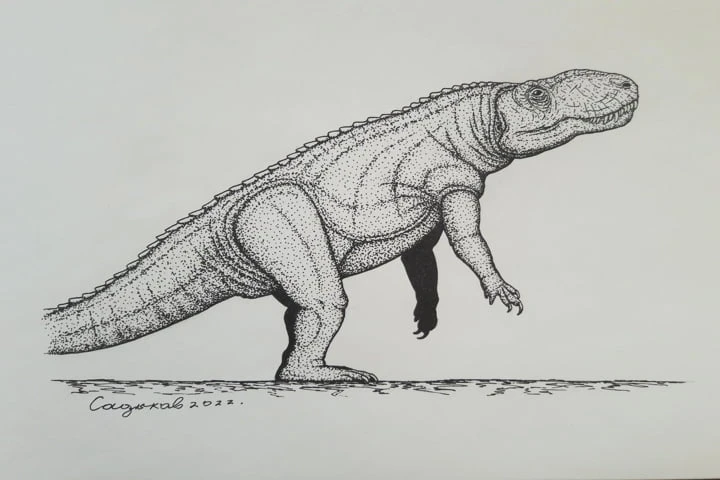

Illustration of Mambawakale ruhuhu from the Triassic period of Tanzania (Pic. Courtesy Twitter/@jimmadseni24)
<p>
<strong>Thousands of years in the past &ndash; 240 million to be precise &ndash; a spine-chilling archosaur roamed Tanzania. What made it menacing were its extremely &ldquo;powerful jaws and large knife-like teeth&rdquo;, according to a recent study cited in livescience.com.</strong></p>
<p>
It was not just the jaws and teeth that were intimidating as the creature of the Triassic period, measured from snout to tail more than 16 feet or five metres and has been christened Mambawakale ruhuhu meaning &ldquo;ancient crocodile from the Ruhuhu Basin&quot; in Kiswahili.</p>
<p>
Professor of paleobiology in United Kingdom&rsquo;s University of Birmingham and the study&rsquo;s lead researcher Richard Butler describing this creature said that it &ldquo;walked on all fours with a long tail&rdquo; and &quot;would have been a very large and pretty terrifying predator&rdquo;.</p>
<p>
In an email to Live Science Butler wrote: <a href="https://www.livescience.com/archosaur-apex-predator-discovered-tanzania?utm_source=SmartBrief&amp;utm_medium=email&amp;utm_campaign=368B3745-DDE0-4A69-A2E8-62503D85375D&amp;utm_content=B5A834B5-B079-4FAA-82C2-1C045C39A865&amp;utm_term=c2029947-e980-4274-bc11-2f4c117930b6" rel="nofollow">&quot;It&#39;s one of the largest predators</a> that we know of from the Middle Triassic [247 million to 237 million years ago].&rdquo;</p>
<p>
The details of the study was published online in the journal Royal Society Open Science.</p>
<p>
Palaeontologists painstakingly studied this ancient creature and took nearly 60 years to describe it. Just two years before Tanzania&rsquo;s independence from Britain, that is in 1963, the fossils of M. ruhuhu were discovered.</p>
<p>
<img alt="" src="https://www.indianarrative.com/upload/news/Mambawakale_ruhuhu_Twitter_SerpenIllus.jpg" style="width: 100%; height: 100%;" /></p>
<p>
<em>Mambawakale ruhuhu (Pic. Courtesy Twitter/@SerpenIllus)</em></p>
<p>
According to the study, the Tanzanians and Zambians played a predominant role in locating fossil hotspots; discovering the fossils, making these sites accessible by building roads; and moving them to the required place. After this their role ended as the fossils were moved to London&rsquo;s Natural History Museum from Ruhuhu Basin in southwest Tanzania.</p>
<p>
<strong>Also read: <a href="https://www.indianarrative.com/science-news/austrian-dinosaur-ankylosaurs-was-both-deaf-and-slow-moving-142887.html">Austrian dinosaur Ankylosaurs was both deaf and slow moving</a></strong></p>
<p>
The specimen of one beast with a 2.5-foot-long or 75 centimetres skull and lower jawbone and a left hand which was fairly complete was named Pallisteria angustimentum by Alan Charig, an English palaeontologist (1927-1997). Charig who played a part in collecting the remains of this ancient creature named it after John Weaver Pallister, his geologist friend.</p>
<p>
This name was never formally published and so when Butler and his team studied the specimen after years they gave it a Kiswahili name. It was as per the study &quot;to formally recognize the substantial and previously unsung contributions of unnamed Tanzanians&quot; on the 1963 expedition.</p>
<p>
Butler who along with Tanzanian neoherpetologist John Lyakurwa from the University of Dar es Salaam named the archosaur remarked: &quot;Our key results are the formal recognition of Mambawakale as a new species for the first time.&rdquo;</p>
<p>
<strong>Also read: <a href="https://www.indianarrative.com/science-news/how-crocodiles-and-birds-survived-a-giant-asteroid-million-years-ago-134370.html">How Crocodiles and Birds Survived a giant Asteroid 66 Million Years Ago</a></strong></p>
<p>
Archosaurs came up at the end of Permian extinction about 252 million years ago and this group included crocodilians and living birds, the extinct pterosaurs and non-avian dinosaurs. M. ruhuhu found during the Middle Triassic period represent the period when archosaurs as per Butler &quot;really start to diversify for the first time&rdquo;.</p>
<p>
Among the nine archosaur specimens found in Tanzania, M. ruhuhu is one. As per Butler, &quot;Mambawakale adds to this picture of a rapid early diversification of archosaurs and moreover was the largest predator within its ecosystem.&rdquo;</p>
External Affairs Minister S Jaishankar on Thursday met a delegation of special envoys from the…
Amnesty International has issued a report demanding the immediate and unconditional release of detained leaders…
India on Thursday dispatched a consignment of 300,000 doses of Measles and Rubella vaccines, along…
At least four people were killed and dozens injured in violent clashes between law enforcement…
An earthquake of magnitude 7.3 on the Richter Scale rattled Alaska in the early hours…
Amid rising global tensions and economic uncertainty, External Affairs Minister S Jaishankar on Wednesday raised…